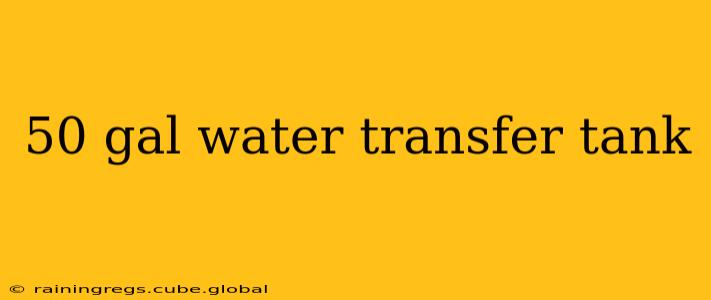Choosing the right water transfer tank can be crucial for various applications, from emergency preparedness to agricultural irrigation and construction. A 50-gallon capacity offers a versatile balance between portability and storage, making it suitable for a range of tasks. This guide delves into the key factors to consider when selecting a 50-gallon water transfer tank, addressing common questions and concerns.
What are 50-Gallon Water Transfer Tanks Used For?
50-gallon water transfer tanks find applications across numerous sectors. Their size makes them ideal for situations requiring a moderate amount of water transport and storage without being overly cumbersome. Common uses include:
- Emergency Preparedness: Storing potable water for emergencies, ensuring a readily available supply in case of natural disasters or disruptions to public services.
- Agricultural Irrigation: Supplying water to smaller crops or gardens, particularly in areas with limited access to larger water sources.
- Construction and Industrial Use: Transporting water to job sites for various purposes, including mixing cement, cleaning equipment, and dust suppression.
- Livestock Watering: Providing water for smaller livestock herds or individual animals in remote locations.
- Recreational Activities: Carrying water for camping, off-roading, or other outdoor pursuits.
What are the Different Types of 50-Gallon Water Transfer Tanks?
Several types of 50-gallon water transfer tanks cater to diverse needs and preferences:
- Plastic Tanks: These are lightweight, relatively inexpensive, and corrosion-resistant. They're often made from high-density polyethylene (HDPE) which is durable and food-grade in some instances.
- Metal Tanks: Typically constructed from steel or galvanized steel, these offer greater strength and durability but are heavier and more susceptible to rust.
- Food-Grade Tanks: Essential for storing potable water intended for human consumption. These tanks must meet specific safety standards to ensure the water remains free from contaminants.
The choice of material depends heavily on the intended use. For potable water, a food-grade plastic tank is generally recommended. For industrial uses where durability is paramount, a metal tank might be preferable.
What are the Key Features to Consider When Choosing a 50-Gallon Water Transfer Tank?
Beyond the material, several key features warrant consideration:
- Durability: Look for tanks made from robust materials that can withstand rough handling and exposure to the elements.
- Portability: Consider the tank's weight and whether it includes features like handles or wheels for easier movement.
- UV Resistance: For outdoor use, choose a tank with UV-resistant properties to prevent degradation from sunlight exposure.
- Fittings and Connections: Ensure the tank has appropriate fittings and connections compatible with your water source and application.
- Weight Capacity (when full): Always account for the significant weight increase when the tank is full.
What is the Best Material for a 50-Gallon Water Transfer Tank?
The "best" material hinges on the intended use. Food-grade HDPE plastic is generally a safe and versatile choice for potable water storage, offering a good balance of durability, lightweight design, and cost-effectiveness. For heavier-duty applications requiring extreme durability, a galvanized steel tank may be more suitable, although it is heavier and needs to be checked for rust.
How Much Does a 50-Gallon Water Transfer Tank Cost?
Prices vary depending on the material, features, and brand. Expect to pay anywhere from a few hundred dollars to over a thousand dollars for a high-quality 50-gallon water transfer tank.
Where Can I Buy a 50-Gallon Water Transfer Tank?
50-gallon water transfer tanks are widely available from various retailers, including:
- Farm and Ranch Supply Stores: These often stock a wide range of tanks suitable for agricultural uses.
- Home Improvement Centers: Major home improvement stores usually carry a selection of plastic water tanks.
- Online Retailers: Numerous online retailers offer a vast selection of tanks from various manufacturers, allowing for easy price comparisons.
Choosing the right 50-gallon water transfer tank involves careful consideration of your specific needs and application. By understanding the available options and key features, you can make an informed decision that meets your requirements for years to come. Remember always to prioritize safety and choose a tank appropriate for the intended use.
